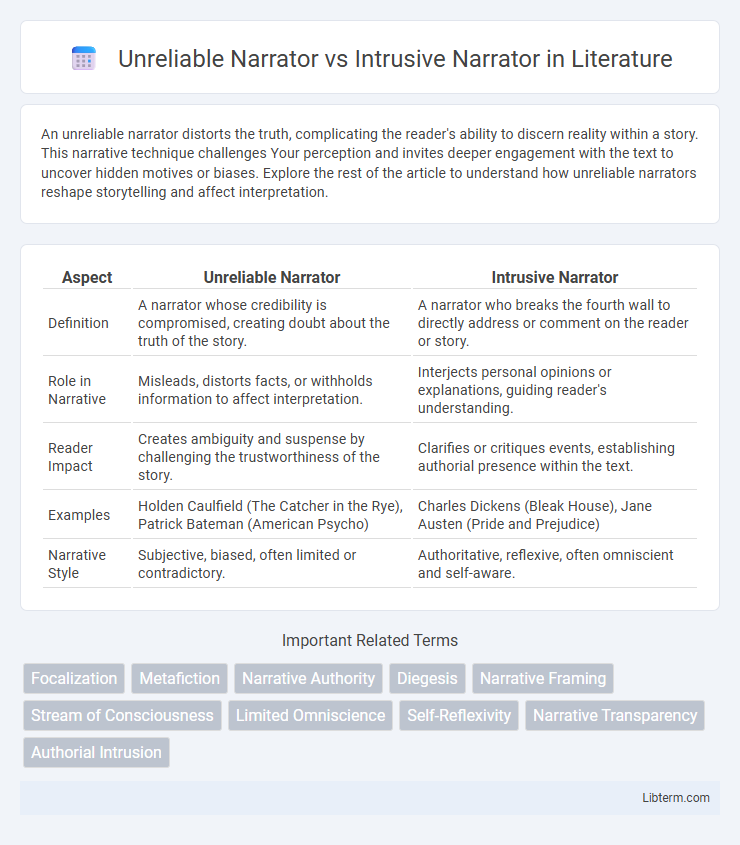An unreliable narrator distorts the truth, complicating the reader's ability to discern reality within a story. This narrative technique challenges Your perception and invites deeper engagement with the text to uncover hidden motives or biases. Explore the rest of the article to understand how unreliable narrators reshape storytelling and affect interpretation.
Table of Comparison
| Aspect | Unreliable Narrator | Intrusive Narrator |
|---|---|---|
| Definition | A narrator whose credibility is compromised, creating doubt about the truth of the story. | A narrator who breaks the fourth wall to directly address or comment on the reader or story. |
| Role in Narrative | Misleads, distorts facts, or withholds information to affect interpretation. | Interjects personal opinions or explanations, guiding reader's understanding. |
| Reader Impact | Creates ambiguity and suspense by challenging the trustworthiness of the story. | Clarifies or critiques events, establishing authorial presence within the text. |
| Examples | Holden Caulfield (The Catcher in the Rye), Patrick Bateman (American Psycho) | Charles Dickens (Bleak House), Jane Austen (Pride and Prejudice) |
| Narrative Style | Subjective, biased, often limited or contradictory. | Authoritative, reflexive, often omniscient and self-aware. |
Introduction to Narrative Perspectives
Unreliable narrators present a skewed or biased version of events, compelling readers to question the truth within the story, whereas intrusive narrators break the fourth wall by directly addressing readers to offer commentary or insights. Narrative perspectives shape a story's reliability and reader engagement, influencing how characters, settings, and plot developments are perceived. Understanding these narrative types enriches literary analysis by highlighting the author's intent and the layers of storytelling technique.
Defining the Unreliable Narrator
An unreliable narrator is a storyteller whose credibility is compromised, often due to limited knowledge, personal bias, or intentional deception, leading readers to question the accuracy of the narrative. This contrasts with an intrusive narrator, who openly breaks the fourth wall and engages directly with the audience without necessarily distorting the story's truth. Understanding the unreliable narrator is crucial for interpreting perspective and narrative reliability in literature.
Characteristics of Intrusive Narrators
Intrusive narrators directly address the reader, often breaking the fourth wall to provide personal commentary or opinions that influence the narrative perspective. They exhibit self-awareness and control over the storytelling, frequently guiding interpretation through subjective insights or editorial remarks. Unlike unreliable narrators, intrusive narrators do not mislead through flawed perception but manipulate the narrative tone by inserting their distinct voice within the story.
Key Differences Between Unreliable and Intrusive Narrators
An unreliable narrator presents a distorted or biased version of events, intentionally or unintentionally misleading the audience due to flawed perception or hidden motives. In contrast, an intrusive narrator directly addresses the reader, often commenting on the story or their own role, breaking the fourth wall without necessarily deceiving. The key difference lies in the unreliable narrator's deceptive or limited perspective versus the intrusive narrator's self-aware and interactive storytelling approach.
Techniques Used by Unreliable Narrators
Unreliable narrators employ techniques such as selective omitting of critical information, distorted perceptions, and deliberate misinformation to manipulate the reader's understanding of the story. Their use of inconsistent or contradictory statements and biased viewpoints creates ambiguity and challenges readers to question the narrative's truthfulness. These techniques engage readers in active interpretation, making the unreliable narrator a powerful tool for adding depth and complexity to literary works.
Methods of Intrusive Narration
Intrusive narration employs direct authorial commentary, breaking the fourth wall to engage readers with subjective insights or thematic reflections. This method contrasts with unreliable narration, where the narrator's credibility is compromised by biased perception or incomplete knowledge. Techniques such as explicit authorial interjections, direct address, and personal opinions characterize intrusive narration, guiding readers toward a particular interpretation of the narrative.
Reader Engagement and Narrator Trust
An unreliable narrator challenges reader engagement by requiring audiences to question the accuracy of the narrative, fostering active interpretation and skepticism. An intrusive narrator directly addresses or comments on the reader, shaping trust through overt narrative control and self-awareness. The interplay between these narrators influences how readers decipher truth and reliability within the story.
Literary Examples: Unreliable vs Intrusive Narrators
Unreliable narrators, such as the protagonist in Edgar Allan Poe's "The Tell-Tale Heart," distort reality through subjective bias or mental instability, while intrusive narrators, exemplified by the omnipresent voice in Jane Austen's "Emma," break the fourth wall by directly addressing the reader and offering commentary. Dostoevsky's "The Brothers Karamazov" features an unreliable narrator whose questionable perspective challenges the reader's trust, contrasting with Charles Dickens's use of an intrusive narrator in "Bleak House," who interjects opinions and explanations. These contrasting narrative techniques shape reader engagement by either creating suspense through doubt or fostering a conversational tone through direct authorial intervention.
Impact on Storytelling and Interpretation
An unreliable narrator distorts reality through biased or false perceptions, forcing readers to question the authenticity of the narrative and engage actively in deciphering the truth. An intrusive narrator directly addresses the audience, guiding interpretation and shaping the story's thematic framework with intentional commentary. The contrast between these narrative styles significantly impacts storytelling by either creating ambiguity and mistrust or providing clarity and interpretive direction.
Choosing the Right Narrator for Your Story
Selecting the right narrator is crucial for shaping your story's impact, with unreliable narrators offering subjective perspectives that challenge readers to discern truth from bias, while intrusive narrators provide direct commentary that guides interpretation. Unreliable narrators enhance mystery and tension by withholding or distorting information, making them ideal for psychological thrillers or complex character studies. Intrusive narrators suit narratives requiring clarity or thematic emphasis, as their explicit interjections and insights can deepen understanding and create a conversational tone.
Unreliable Narrator Infographic

 libterm.com
libterm.com